Climate Change Vulnerability Assessment and Adaptation in Greater Banjul – Gambia
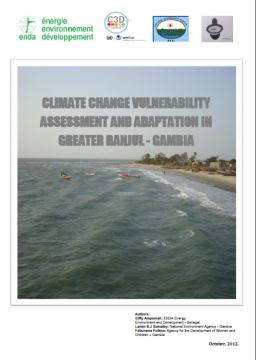

Executive Summary
The Gambia, situated in West Africa, 13° 28.02′ N and 16° 34.02′ W, is located squarely in the river Gambia Delta, which effectively separates the country into two halves from north to south. It is surrounded on all three sides by Senegal and boarded to the west by the North Atlantic Ocean. It constitutes a total land area of 11,300 square kilometres: 1,300 sq/km covered with water and 10,000 sq.km being the total land mass.
The Greater Banjul area is about 93 sq km and a population size of 357,000 (26% of the total country’s population). Like most African cities, the city has been an economic hatch for most Gambians. It hosts people from all over the country for commercial purposes. Some economic activities in addition to commerce are crafts making, tourism and hotel services, fishing, oyster collection, and production of rice, groundnut as well as other agricultural crops. However, over the last decade and with urbanization, most arable lands have been turned into settlements for the increasing population which has partly resulted from people immigrating to this area from their rural communities for greener pastures.
Using the Adaptation Toolkit (a guide book for researchers and adaptation practitioners working with local communities), which was produced by ENDA and SEI, this study on vulnerability and adaptation to climate change conducted reveals that, the area is exposed to erratic rainfall patterns;, increasing temperatures and rising sea-levels. Some consequential effects of these extreme events have been flooding, dry spells, storms (wind, thunder and dust), droughts, cool spells, heat waves, beach erosion, outbreak of parasitic diseases, outbreak of crop pest and saline intrusion into productive soil, river and underground fresh water.
In trying to find responses to these problems, residents receive support from existing social networks, community-based organizations, non-governmental organizations and some governmental institutions. Community-based organizations are said to be at the forefront of efforts to reduce risk, some of these include creation of water ways to enhance drainage, extension of pipe borne water to areas affected by saline intrusion and floods to ensure access to clean and potable water. Apart from these, communities have had their coping strategies for various hazards but these have not been effective or sufficient.
In planning for adaptation actions, community members proposed to have a range of interventions such as good road network, potable water and electricity supply, well equipped health facility, basic schools, and many other strategies. With the help of the Adaptation Decision Explorer tool (output of this exercise can be downloaded from: http://weadapt.org/placemarks/maps/view/837), these options were screened helping community members to decide as an immediate measure, to halt encroachment on wetlands which also aggravates flood problems during rainy seasons.
The Study Area
The Greater Banjul area is about 93 sq km and a population size of 357,000 (26% of the total country’s population). It consists of two municipalities which are Banjul and the Kanifing (the greater of the two and also known as the Kombos). Though the Banjul Old town is still the seat of government, it only hosts a few of government departments with most of them relocated in recent years to Kanifing. The emergence of commercial centers in Kanifing makes it the most populous municipality in the country. It also has the major hotels and tourist centers of the country. Since 1963, its population has increased from 12000 to 322700 in 2003. Figure 3 below presents the population growth of the Kanifing municipality as compared to the other parts of the Area.
Though an urban area, it also portrays some of the country’s rich biodiversity with mangrove swamps, wetlands mudflats which are homes for different bird species. Apart from commercial and official activities, some local communities are also engaged in agricultural activities which depend on natural resources and are sensitive to climate variations. Two of such communities are the Lamin and Ebo town communities. This study was based in these two communities to fully understand how vulnerable the Kombos are to climate variability and change.
Ebo Town: Vegetation cover barely exist in Ebo Town with trees cleared to make way for housing.There are few palm trees and mangroves along the river bank. The soil comprises of clay and silt and therefore water logging, during the rains.
Lamin:There is a conservation park that remain largely untouched by the expanding settlement. A narrow strip of land populated by species of grasses and trees in the eastern part as well as a long stretch of mangrove along the river bank and few privately owned woodlots, which collectively constitutes the vegetation cover.The soil is characteristically loamy and silt. The topography is sloppy at some points and this enhances erosion during rains.
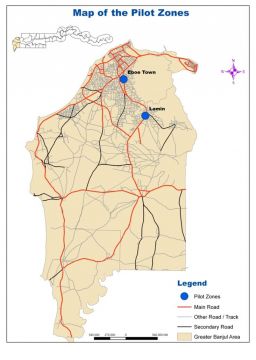
Map of pilot locations
Current Vulnerabilities
The hazard profile resulted from the vulnerability mapping activities reveals that, events currently affecting people include droughts, windstorms, outbreak of crop pest, high intensity rains and flash floods which causes erosion, dry spell, saline intrusion into productive soil, river and underground water. Characteristics of these events are as follows:
- High intensity of rains which is normally associated with flooding occur mostly in August and September and contribute to outbreak of diseases such as diarrhea, malaria, cholera and some skin infections.
- Windstorms are mainly in May, June and September but the violent ones are usually at the onset of the rainy season. Windstorms affects infrastructure- both private and public.
- The problem of salinity is observed by community members to be high during periods with high temperatures and dry conditions. These negatively affect rice fields situated along the river banks. It is severe in March, April and May.
- Dust storms is a characteristic of the dry season, however, it is most pronounced in February and March, periods when the ground cover is mostly gone due to bush burning, grazing and removal of crop residue.
- Pest infestation is sporadic but crops are mainly vulnerable while in their vegetative state. The commonest types of pest include locusts, beetles, grasshoppers, grass cutters, etc.
Flooding and windstorm were found to be the most frequent and severest of all climate related hazards in Lamin and Ebo Town. Floods and windstorms have caused a number of casualties in both communities in the 2000s; two youngsters died in Ebo Town when an overblown roof fell on them on 11th September, 2001; in 2011, two other youngsters were said to have been washed away into a covered drain resulting in their untimely deaths in Lamin. Drought and locust invasion were found to be not frequent but also caused severe impacts when they occur, whilst dry spells also with significant impacts, is said to be an annual phenomenon.
Impacts on livelihoods
- Fishing: When there are severe windstorms, it becomes risky for fishermen to go and conduct fishing on both the sea and the river. Consequently, there is a shortage of fish supply on local markets which also results in high prices.
- Oyster collection: when there are floods during the raining season, the harvesting of oysters ceases, as it is considered poisonous to consume the product. Thus run-offs from rain into the river pollute the oysters which make them dangerous to consume. Therefore, women who are engaged in this activity normally strive to find alternative livelihood activities during the rainy season.
- Vegetable production: Salinity, erratic rainfall and pest infestations affect vegetable farming in this area. Intrusion of salt water from the sea makes some of the land uncultivable; fresh water shortage restricts many people from embarking on cultivation and pest affects the quality of crops.
- Petty trading: Is by and large affected by the performance of cropping season (both rain fed and irrigation). A good season harvest does not only enhance a vibrant market but, help to stabilize prices. When the reverse occurs, in addition to food insecurity, the purchasing power of families is significantly reduced.
- Micro savings: To a large extent, help to boost the financial status of women through soft loan schemes that does not necessarily carry interest. However, the sustainability of this scheme hinges on individuals’ earning, which is also determined by the performance of the cropping season. A massive crop failure either as a result of pest attack or inadequate rains could render this micro-financial activity hard to implement.
Climate trends and Scenarios
Rainfall:-
Data observed in past years(1979-2000) show that onset of rains is in june, peaks in september and ends in november. This indicates that there are only five wet months in the whole year and a lenghty period od dryness.Models in the future projectin pridicts a possible decrease even in the wettest months of the rainy season hence a pottential course for concern, especially for food security. A shift in the patterns of rains would limits farmers options in crop selection; only the early maturing varieties could be selected, whilst those that require adequate water will unadoidably be ignored.These includes some of the essentail crops that constitutes staple food as in rice and maize.
Rainfall projections in Gambia
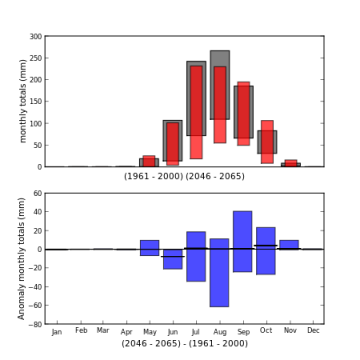
Future rainfall partterns
Projected monthly dry spells in Gambia
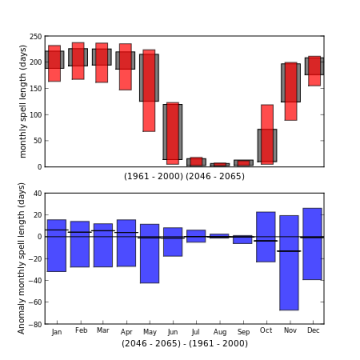
Dry spells duration
Temperature
Data observed from 1961 -2000 show highest minimum temperature at 25 degree celsus and with the future trends, some models projets a possible increase of 2.5 degrees celsus. If those are anything to go by, the implications are that we are expecting more warmer and dryier conditions which will ultimately affect various facets of life and livelihoods. Increase in sea/river temperatures will triger rise in water levels and this pose a pottential threat to infracture along the sea front/ river banks.
Temperature projections
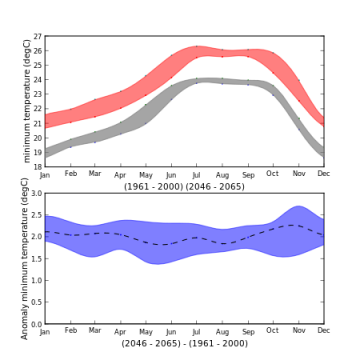
projected temperature in Gambia
Major Stresses
Climatic stress: Drought (More drier conditions to be expected)
Non climatic stress: Population Growth
Most Vulnerable group: Farmers (rice and vegetable producers)
Observation:From the Climate Information Portal(CIP), it was realised that there is the probability of more drier conditions to be experienced in the Greater Banjul area between the period (2045- 2065). Therefore it is expected that, if population continues to grow, there will be a decrease in land per capita for food production, land degradation due to over cultivation for the limited land available and a general decrease in forest cover.
Adaptation options at the local level
-
- Extension of electricity supplies to cover those areas currently without electricity.
- Extension of road networks with adequate drainage systems to facilitate easy communication in parts of the community as well as facilitating the uninterrupted movement of run-off water into the river during rains.
- Extension of pipe borne water to ensure each and every part of the community has access to clean and safe drinking water.
- Availability of well equipped health centre in the community capable of handing most of the healthcare needs of the people.
- Availability of well equipped Lower Basic schools as well as skills training centres to ensure that young people have access to primary level education and skill training facilities at their disposal. This will enable them to diversify their economic activities.
- Availability of a well equipped police station within the community.
- Halt encroachment on wetlands and setting systems to monitor this action.
The ADx tool was used to screen these adaptation strategies mentioned above, looking the outcome of the tool as shown in figure 14 below, “halting encroachment on wetlands and setting systems to monitor this action” was the option chosen. With a reflection on the cost criteria and the most urgent and feasible action, community members agreed that, this is an action which could be taken as the encroachment on wetlands leads to loss of biodiversity and also aggravates flooding during rainy season.
Tools and methods used
Using mixed methods (both qualitative and quantitative)
Data sources:
1.Primary Data (field research using focus group discussions) 2.Secondary data sources (Meteorology department, downscale data from CIP)Tools:
•The Adaptation Tool Kit – (Resources mapping, Capacity mapping, trend analysis and historical disturbance profile, current vulnerability mapping, Climate change perceptions, participatory scenario building and back casting and the Adaptation screening tool) •The Climate Information Portal to access climate information (CIP).Conclusion
The Greater Banjul is vulnerable to climate variability and change due to their exposure, high sensitivity and inadequate/low adaptive capacity of people to respond effectively to these challenges. The area is rich in various types of resources, especially biophysical ones. However, their exposure to various types of climate related hazards threatens their existence. The area is exposed to erratic rainfall patterns, rising temperatures and sea-levels. Some consequential effects of these extreme events have been torrential rains, dry spells, storms surges, droughts, cool spells, heat waves, beach erosion, outbreak of parasitic diseases, outbreak of crop pest and saline intrusion into productive soil, river and underground fresh water.
These problems are also aggravated by some existing non-climatic challenges in the Greater Banjul Area, which retards adaptation efforts; these were mentioned as late and inadequate responses to hazards, limited understanding of community members on the climate change phenomenon, insufficient/less effective coping mechanisms, difficulties in waste management and inadequate disaster preparedness.
A forecast into likely future climate scenarios, shows that average maximum temperatures are likely to continue increasing where as rainfall patterns in this region remain highly uncertain with likely increase in its intensity. There is therefore the need for robust adaptation strategies that would help to deal with current problems, and aren’t reliant on specific projections of change.
In response to these hazards, communities normally receive aid from available institutions such as social groups, NGOs and government development committees. These are also complemented by various coping mechanisms developed by community members themselves. However, these supports are not all sufficient in dealing with all the challenges. In the coming years, with the likelihood of more uncertain climatic hazards, it could be very difficult for people living in this area if business should continue as usual as realized in this study without any aggressive interventions with regards to adaptation.
It has been realized that with the strengthening of available institutional support and effective coordination between community members and various institutions, there could be better ways for people to adapt to these climate impacts. Also, as community members have been able develop their own adaptation plans and decisions, this makes them ready for any institutional support and also alerts the need for their engagement in implementing some these actions.
(0) Comments
There is no content